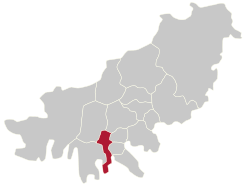Busan Institute of Science and Technology is a private college located in Buk District, Busan, South Korea. It was called Busan College of Information Technology until February 2012.
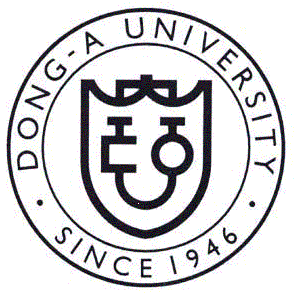
Dong-A University is a private university in Busan, South Korea. It is the only private university and one of two universities that has both a medical school and a law school in Busan, the second-largest city in South Korea.

Haeundae District is a district (gu) of Busan, South Korea.

Dongnae District is a gu in central Busan, South Korea.
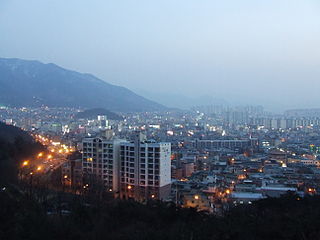
Dalseo District is a district in western Daegu, South Korea. It borders Dalseong-gun on the north, south, and west, and Seo-gu and Nam-gu on the east. It has a population of about 610,000, and an area of 62.27 square kilometers. The population rose dramatically in the 1990s, and has been approximately level since 2000.

Nam is a gu, or district, in south-central Busan, South Korea. Much of Nam-gu sticks out into the Sea of Japan, forming a peninsula which separates Suyeong Bay from Busan Harbor. It has an area of 25.91 km2. Nam-gu officially became a gu of Busan in 1975. In 1995 part of Nam-gu was divided to form Suyeong-gu.

Geumjeong District is a district in north central Busan, South Korea. Approximately 7.3% of Busan's population is in Geumjeong-gu. The Hoedong Reservoir is located on the district's eastern boundary, and the mountain Geumjeongsan on the west. Because of this, 75% of the district's land is restricted from residential development. The district's population is concentrated in the valley of the Oncheoncheon stream, a tributary of the Suyeonggang.
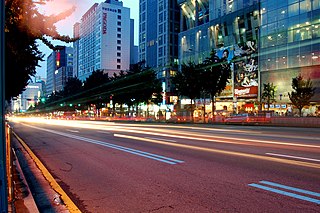
Seodaemun District is one of the 25 districts of Seoul, South Korea.

Suyeong District (Korean: 수영구) is a district (gu) in central Busan, South Korea. It has a population density of about 17,768 inhabitants per square kilometer (46,020/sq mi).
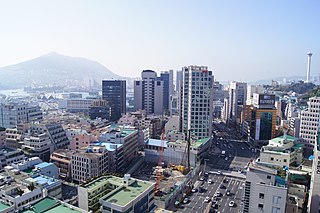
Jung District is a gu in southern central Busan, South Korea. It has an area of 2.8 km², and a population of about 48,000.
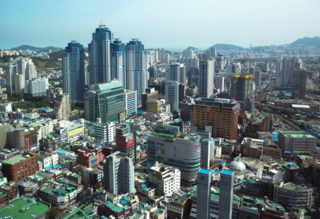
Busanjin District is a gu in central Busan, South Korea. It has an area of 29.7 km2, and a population of about 410,000. The name is sometimes abbreviated locally as "Jin-gu". Busanjin-gu is home to a major shopping, entertainment, and business area called Seomyeon.

Saha District is a gu in western Busan, South Korea. It has an area of 40.89 km², and a population of about 375,000. About a third of the area is forest land. Saha-gu became a gu of Busan in 1983. It is home to the Seunghak Campus of Dong-A University.

Yeonje District is a gu in central Busan, South Korea. It has an area of 12.08 km2, and a population of about 220,000. Yeonje-gu was created in March 1995 following its separation from Dongnae-gu. Its name was formed by taking the first and last syllables of the names of its only 2 legal dong; Yeonsan-Dong and Geoje-Dong. Busan City Hall is located in Yeonje-gu.

Yeongdo District (Korean: 영도구) is a gu (district) in Busan, South Korea. The gu itself is limited to Yeong-do located on the south edge of central Busan. It attained the status of gu in 1957.

Dong District is a gu in central Busan, South Korea. It was one of the first 6 gu of Busan established in 1957.

Jung District is a gu, or district, covering the downtown area of Daegu, South Korea. It borders most of the other districts of Daegu, including Nam-gu to the south, Seo-gu to the west, Buk-gu to the north, and Dong-gu and Suseong-gu to the east. The northern border is formed by the Gyeongbu Line railroad, and the eastern border by the Sincheon stream.

Dongdaemun District is one of the 25 districts of Seoul, South Korea.

Geumcheon District (Geumcheon-gu) is one of the 25 gu (districts) of Seoul, South Korea. It was created from southern parts of Guro-gu and tiny sections from Gwangmyeong in 1995. Its district office is located in front of Siheung Station, now Geumcheon-gu Office Station, in Siheung-dong.

Nam District (Nam-gu) is a district of Ulsan, South Korea. Its name literally means "South Ward".

Geumseong is a dong, or precinct, in Geumjeong-gu, Busan, South Korea. A lightly populated district, it is situated entirely within the mountain range of Geumjeongsan. It is bounded to the west by Hwamyeong-dong and Geumgok-dong in Buk District, to the northwest by Dong-myeon of Yangsan City, to the east by Cheongnyong-dong, Namsan-dong, Guseo-dong, and Jangjeon-dong of Geumjeong-gu, and to the south by Oncheon-dong in Dongnae-gu. The northernmost point in Geumseong-dong is at Godang-bong, the highest peak in Geumjeongsan.

